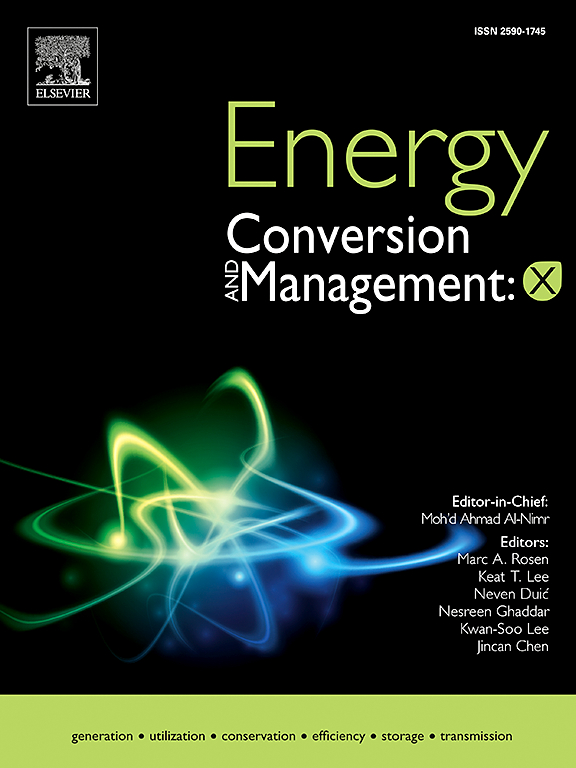典型生物降解塑料燃料性能的多维评价
IF 7.1
Q1 ENERGY & FUELS
引用次数: 0
摘要
由于生物降解塑料的传统回收和处理系统不明确,容易造成新的环境污染,燃料转化有望成为一种可行的处理方法。本文从燃烧特性、热重过程、动力学和热力学参数等方面研究了四种典型bp的燃料利用性能。结果表明,bp的热值为17.84 ~ 24.21 MJ/kg,与标准煤相当,N、S含量均在1%以下。bp的反应温度一般在300 ~ 600℃,这表明它们相对容易燃烧。此外,采用FWO法、KAS法和Starink法计算的bp燃烧过程所需的表观活化能(Eα)仅为71.88 ~ 114.39 kJ/mol。较低的燃烧反应能垒使bp成为高燃烧能垒物质的理想共燃剂。bp在各个阶段的燃烧过程主要符合An模型(随机成核和核生长机制模型),不同阶段的反应顺序不同。表观焓变和吉布斯自由能变化均大于0,表明bp的燃烧是非自发反应,需要从外界环境中吸收能量。这些发现有望为设计BP燃烧反应堆提供重要见解,并为其燃料转换应用奠定理论基础。本文章由计算机程序翻译,如有差异,请以英文原文为准。

Multidimensional Evaluation of fuel performance for typical biodegradable plastics
Biodegradable plastics (BPs) are prone to causing new environmental pollution because the traditional recycling and disposal systems on BPs are unclear, fuel conversion is expected to emerge as a viable treatment method. Here, the performance of four typical BPs for fuel utilization with combustion characteristics, thermogravimetric processes, as well as kinetic and thermodynamic parameters were studied. The results indicated that the calorific values of the BPs were 17.84–24.21 MJ/kg, comparable to standard coal, and their N and S contents were below 1 %. The reaction temperatures of BPs generally range from 300 to 600°C, which indicated that they were relatively easy to burn. In addition, the apparent activation energy (Eα) required for the combustion process of the BPs calculated by the FWO, KAS, and Starink methods is only 71.88–114.39 kJ/mol. The lower combustion reaction energy barrier makes BPs promising co-firing agents for substances with high combustion energy barriers. The combustion process of BPs across all stages predominantly conforms to the An model (random nucleation and nuclei growth mechanism model), with varying reaction orders observed in distinct phases. The apparent enthalpy change and Gibbs free energy change are both greater than 0, indicating that the combustion of BPs was a nonspontaneous reaction that requires the absorption of energy from the external environment. These findings are anticipated to provide critical insights for designing BP combustion reactors and establish a theoretical foundation for their fuel conversion applications.
求助全文
通过发布文献求助,成功后即可免费获取论文全文。
去求助
来源期刊

Energy Conversion and Management-X
Multiple-
CiteScore
8.80
自引率
3.20%
发文量
180
审稿时长
58 days
期刊介绍:
Energy Conversion and Management: X is the open access extension of the reputable journal Energy Conversion and Management, serving as a platform for interdisciplinary research on a wide array of critical energy subjects. The journal is dedicated to publishing original contributions and in-depth technical review articles that present groundbreaking research on topics spanning energy generation, utilization, conversion, storage, transmission, conservation, management, and sustainability.
The scope of Energy Conversion and Management: X encompasses various forms of energy, including mechanical, thermal, nuclear, chemical, electromagnetic, magnetic, and electric energy. It addresses all known energy resources, highlighting both conventional sources like fossil fuels and nuclear power, as well as renewable resources such as solar, biomass, hydro, wind, geothermal, and ocean energy.
 求助内容:
求助内容: 应助结果提醒方式:
应助结果提醒方式:


